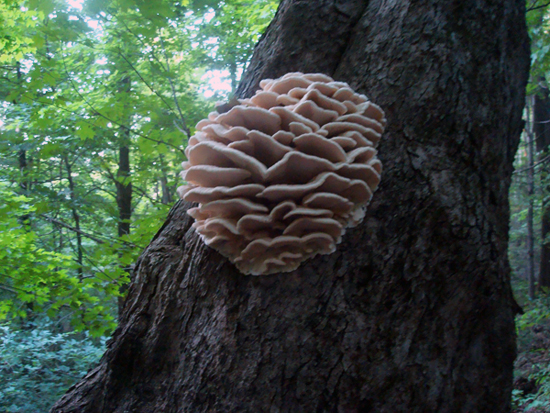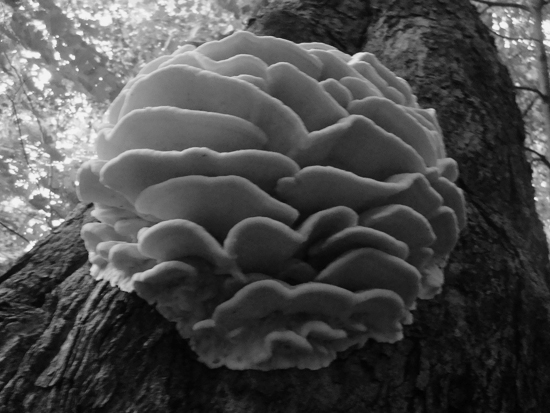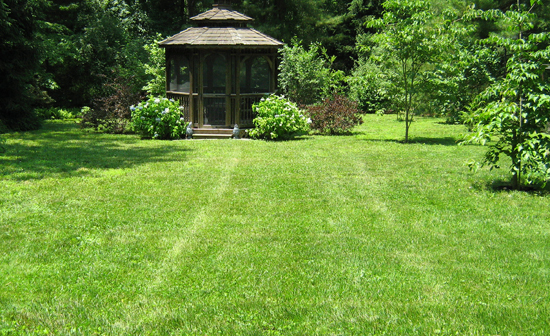Organic
 Beautiful Fungus!
Beautiful Fungus!
 During one of my recent walks in the woods at Mohonk, my friends and I came upon this beautiful fungus!
It appears to be a shelf fungus known as Laetiporus sulphureus – also known as “Chicken of the Woods” – though this young specimen is not as yellow as that species is known to be. It is likely at least a close relative, though, or just a purely whiter young bloom that has yet to yellow with maturity. Recent DNA studies have split up what used to be universally recognized as L. sulphureus into six different species in North America alone, but L. sulphureus is the one that tends to take up residence in the Northeast.
Chicken of the Woods - like the title suggests - is edible. No hallucinations or anything, but you know, if you’re ever in a bind for food…
I feel bad for the tree, though. This fungus is not just saprobic (feeds on dead trees) but also parasitic (feeds on live ones). It is a heart rot fungus and is seen high up on the tree, as you can see in the photo. Of course, by the time you can see it in full-Chicken bloom, it’s already too late.
The heart has rotted.
The tree will die.
Such is the seeming relationship between beauty and death.
And so, the forest becomes its own stage for tragedy, unfolding its quiet story before the wanderers attuned to its mysteries.
During one of my recent walks in the woods at Mohonk, my friends and I came upon this beautiful fungus!
It appears to be a shelf fungus known as Laetiporus sulphureus – also known as “Chicken of the Woods” – though this young specimen is not as yellow as that species is known to be. It is likely at least a close relative, though, or just a purely whiter young bloom that has yet to yellow with maturity. Recent DNA studies have split up what used to be universally recognized as L. sulphureus into six different species in North America alone, but L. sulphureus is the one that tends to take up residence in the Northeast.
Chicken of the Woods - like the title suggests - is edible. No hallucinations or anything, but you know, if you’re ever in a bind for food…
I feel bad for the tree, though. This fungus is not just saprobic (feeds on dead trees) but also parasitic (feeds on live ones). It is a heart rot fungus and is seen high up on the tree, as you can see in the photo. Of course, by the time you can see it in full-Chicken bloom, it’s already too late.
The heart has rotted.
The tree will die.
Such is the seeming relationship between beauty and death.
And so, the forest becomes its own stage for tragedy, unfolding its quiet story before the wanderers attuned to its mysteries.

 Where the Grass is GREENer
Where the Grass is GREENer
by Connie Adamo (guest blogger and Ayesha's Mom)
 I have a little place not too far from the Jersey Shore and have gardened for a number of years. I love the extraordinary variety and abundance of life in my yard. Over the years, using sustainable practices, I have been able to create a little haven.
Today I will talk about having a green lawn without poisoning the environment and killing wildlife – a place where children can play without becoming contaminated by truly frightening pesticides, herbicides and fertilizers – a lawn that can be maintained with very little, if any, watering.
First, it is important to know your growing conditions, i.e. your area of the country, local soil conditions (in your yard) and the amount of light the area receives. I find that careful observation is a great help here. You may also contact your county soil conservation office and many universities have a cooperative extension service that can help with soil testing if you need it. Once you have an idea of what your conditions are and make soil amendments if needed, you should seed with grasses that will thrive in those conditions. In my area, which is Zone 7 and the Northeast, the following grasses are usually successful: fine fescues, red chewing fescues and hard fescues with a small dose, maybe 15%, of perennial rye grass. There are many seed mixtures that contain these grasses. I also include white clover and a happy collection of volunteer greens and assorted acceptables, which can be any low growing ground cover that doesn’t look awful and blends.
My yard is large with varied conditions. I use fescues and white clover near the house, and towards the back, which is quite sunny, I use the grasses and clover mixed with buttercup, wild strawberry, violets, and gill-over-the-ground. I even include a few dandelion and plantain. Having this variety of grasses and plants helps to prevent disease and pests that monoculture invites.
Fertilizing my lawn is usually done twice a year, spring and fall, although it can be less, as it is important not to overfeed. Organic fertilizers are available at many garden centers and in catalogs. Some choices may be dehydrated cow manure, compost and corn gluten meal. Corn gluten meal can be used as a pre-emergent herbicide for crabgrass and broadleaf weeds you may not want. If using corn gluten meal, apply four to six weeks after sowing seeds. I usually overseed with grass and clover in spring and/or fall. I just throw it around where the lawn seems to need it.
With regards to mowing, mow between 3 and 4 inches high and leave the clippings on the ground to fertilize the grass. Mowing high will protect the grass and cut down on watering. Watering should not be necessary unless there are extraordinary conditions. The lawn may go dormant but it will be just fine.
There are also many other earth friendly ways to landscape your space and create a backyard that is busy with life and beauty, but that would be another topic.
I have a little place not too far from the Jersey Shore and have gardened for a number of years. I love the extraordinary variety and abundance of life in my yard. Over the years, using sustainable practices, I have been able to create a little haven.
Today I will talk about having a green lawn without poisoning the environment and killing wildlife – a place where children can play without becoming contaminated by truly frightening pesticides, herbicides and fertilizers – a lawn that can be maintained with very little, if any, watering.
First, it is important to know your growing conditions, i.e. your area of the country, local soil conditions (in your yard) and the amount of light the area receives. I find that careful observation is a great help here. You may also contact your county soil conservation office and many universities have a cooperative extension service that can help with soil testing if you need it. Once you have an idea of what your conditions are and make soil amendments if needed, you should seed with grasses that will thrive in those conditions. In my area, which is Zone 7 and the Northeast, the following grasses are usually successful: fine fescues, red chewing fescues and hard fescues with a small dose, maybe 15%, of perennial rye grass. There are many seed mixtures that contain these grasses. I also include white clover and a happy collection of volunteer greens and assorted acceptables, which can be any low growing ground cover that doesn’t look awful and blends.
My yard is large with varied conditions. I use fescues and white clover near the house, and towards the back, which is quite sunny, I use the grasses and clover mixed with buttercup, wild strawberry, violets, and gill-over-the-ground. I even include a few dandelion and plantain. Having this variety of grasses and plants helps to prevent disease and pests that monoculture invites.
Fertilizing my lawn is usually done twice a year, spring and fall, although it can be less, as it is important not to overfeed. Organic fertilizers are available at many garden centers and in catalogs. Some choices may be dehydrated cow manure, compost and corn gluten meal. Corn gluten meal can be used as a pre-emergent herbicide for crabgrass and broadleaf weeds you may not want. If using corn gluten meal, apply four to six weeks after sowing seeds. I usually overseed with grass and clover in spring and/or fall. I just throw it around where the lawn seems to need it.
With regards to mowing, mow between 3 and 4 inches high and leave the clippings on the ground to fertilize the grass. Mowing high will protect the grass and cut down on watering. Watering should not be necessary unless there are extraordinary conditions. The lawn may go dormant but it will be just fine.
There are also many other earth friendly ways to landscape your space and create a backyard that is busy with life and beauty, but that would be another topic.
 I have a little place not too far from the Jersey Shore and have gardened for a number of years. I love the extraordinary variety and abundance of life in my yard. Over the years, using sustainable practices, I have been able to create a little haven.
Today I will talk about having a green lawn without poisoning the environment and killing wildlife – a place where children can play without becoming contaminated by truly frightening pesticides, herbicides and fertilizers – a lawn that can be maintained with very little, if any, watering.
First, it is important to know your growing conditions, i.e. your area of the country, local soil conditions (in your yard) and the amount of light the area receives. I find that careful observation is a great help here. You may also contact your county soil conservation office and many universities have a cooperative extension service that can help with soil testing if you need it. Once you have an idea of what your conditions are and make soil amendments if needed, you should seed with grasses that will thrive in those conditions. In my area, which is Zone 7 and the Northeast, the following grasses are usually successful: fine fescues, red chewing fescues and hard fescues with a small dose, maybe 15%, of perennial rye grass. There are many seed mixtures that contain these grasses. I also include white clover and a happy collection of volunteer greens and assorted acceptables, which can be any low growing ground cover that doesn’t look awful and blends.
My yard is large with varied conditions. I use fescues and white clover near the house, and towards the back, which is quite sunny, I use the grasses and clover mixed with buttercup, wild strawberry, violets, and gill-over-the-ground. I even include a few dandelion and plantain. Having this variety of grasses and plants helps to prevent disease and pests that monoculture invites.
Fertilizing my lawn is usually done twice a year, spring and fall, although it can be less, as it is important not to overfeed. Organic fertilizers are available at many garden centers and in catalogs. Some choices may be dehydrated cow manure, compost and corn gluten meal. Corn gluten meal can be used as a pre-emergent herbicide for crabgrass and broadleaf weeds you may not want. If using corn gluten meal, apply four to six weeks after sowing seeds. I usually overseed with grass and clover in spring and/or fall. I just throw it around where the lawn seems to need it.
With regards to mowing, mow between 3 and 4 inches high and leave the clippings on the ground to fertilize the grass. Mowing high will protect the grass and cut down on watering. Watering should not be necessary unless there are extraordinary conditions. The lawn may go dormant but it will be just fine.
There are also many other earth friendly ways to landscape your space and create a backyard that is busy with life and beauty, but that would be another topic.
I have a little place not too far from the Jersey Shore and have gardened for a number of years. I love the extraordinary variety and abundance of life in my yard. Over the years, using sustainable practices, I have been able to create a little haven.
Today I will talk about having a green lawn without poisoning the environment and killing wildlife – a place where children can play without becoming contaminated by truly frightening pesticides, herbicides and fertilizers – a lawn that can be maintained with very little, if any, watering.
First, it is important to know your growing conditions, i.e. your area of the country, local soil conditions (in your yard) and the amount of light the area receives. I find that careful observation is a great help here. You may also contact your county soil conservation office and many universities have a cooperative extension service that can help with soil testing if you need it. Once you have an idea of what your conditions are and make soil amendments if needed, you should seed with grasses that will thrive in those conditions. In my area, which is Zone 7 and the Northeast, the following grasses are usually successful: fine fescues, red chewing fescues and hard fescues with a small dose, maybe 15%, of perennial rye grass. There are many seed mixtures that contain these grasses. I also include white clover and a happy collection of volunteer greens and assorted acceptables, which can be any low growing ground cover that doesn’t look awful and blends.
My yard is large with varied conditions. I use fescues and white clover near the house, and towards the back, which is quite sunny, I use the grasses and clover mixed with buttercup, wild strawberry, violets, and gill-over-the-ground. I even include a few dandelion and plantain. Having this variety of grasses and plants helps to prevent disease and pests that monoculture invites.
Fertilizing my lawn is usually done twice a year, spring and fall, although it can be less, as it is important not to overfeed. Organic fertilizers are available at many garden centers and in catalogs. Some choices may be dehydrated cow manure, compost and corn gluten meal. Corn gluten meal can be used as a pre-emergent herbicide for crabgrass and broadleaf weeds you may not want. If using corn gluten meal, apply four to six weeks after sowing seeds. I usually overseed with grass and clover in spring and/or fall. I just throw it around where the lawn seems to need it.
With regards to mowing, mow between 3 and 4 inches high and leave the clippings on the ground to fertilize the grass. Mowing high will protect the grass and cut down on watering. Watering should not be necessary unless there are extraordinary conditions. The lawn may go dormant but it will be just fine.
There are also many other earth friendly ways to landscape your space and create a backyard that is busy with life and beauty, but that would be another topic.
